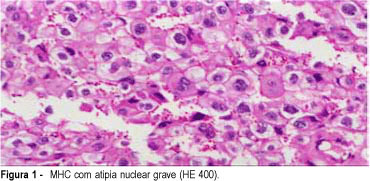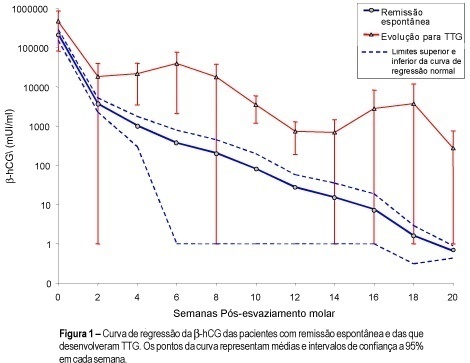Summary
Revista Brasileira de Ginecologia e Obstetrícia. 1998;20(7):415-419
DOI 10.1590/S0100-72031998000700008
Twin pregnancy in which a normal fetus and a complete mole develop at the same time is a rare event. Clinical complications and malignancy are frequent in this type of disease.This report is about a case of a late diagnosis due to the presence of the fetus. The diagnosis was made when the pregnancy was interrupted and then confirmed by histopathological study and flow cytometry. The pregnancy was terminated transpelvically due to massive uterine hemorrhage. The post-molar follow-up showed the persistence of high levels of bhCG. The patient's complete recovery was achieved after the administration of methotrexate. The diagnosis, natural history, and procedures for this rare disease are discussed in view of this case.

Summary
Revista Brasileira de Ginecologia e Obstetrícia. 2000;22(3):167-173
DOI 10.1590/S0100-72032000000300008
Purpose: to determine the most efficient clinical and histopathological predictors of complete hydatidiform mole (CHM) after gestational trophoblastic tumors (GTT). Methods: a prospective clinical and histopathological study was performed on all patients with CHM treated at the University Hospital of Botucatu between 1990 and 1998. Preevacuation clinical evaluation allowed the classification of molar pregnancy into high risk and low risk CHM. The author analyzed the clinical predictors of GTT established by Goldstein et al.¹ and by other authors2--10. The histopathological evaluation included the confirmation of CHM diagnosis based on the criteria by Szulman and Surti11 and the understanding of risk factors for GTT by Ayhan et al.8. The clinical and histopathological predictors were correlated with the postmolar GTT. Results: ovarian cysts larger than 6 cm and uterus size larger than 16 cm were the most efficient clinical predictors of GTT in 65 patients with CHM. Trophoblastic proliferation, nuclear atypia, necrosis/hemorrhage, trophoblastic maturation, and the ratio cytotrophoblast to syncytiotrophoblast were not significant predictors of GTT. The correlation between the clinical and histopathological predictors for the development of GTT was not possible, as no histopathological parameter was significant. Conclusion: additional investigations could evaluate other predictors for persistent disease, and its usefulness in a clinical context. The sequential determination of plasmatic beta-hCG remains the only safe predictor for persistent disease.

Summary
Revista Brasileira de Ginecologia e Obstetrícia. 2000;22(6):373-380
DOI 10.1590/S0100-72032000000600008

Summary
Revista Brasileira de Ginecologia e Obstetrícia. 2003;25(6):445-448
DOI 10.1590/S0100-72032003000600010
Development of preeclampsia/eclampsia prior to 20 weeks of pregnancy should raise the suspicion of hydatidiform mole. We report a case of complete hydatidiform mole (CHM) concurrent with eclampsia in a 20-year-old patient with vaginal bleeding, anemia, large uterine size, and ovary cysts associated with hypertension and proteinuria. Plasmatic b-hCG levels were high and there was abnormal thyroid function. The ultrasonographic findings were compatible with CHM. After uterine evacuation, the patient had headache and visual alterations, followed by tonic-clonic seizures, which ceased with the administration of 50% magnesium sulfate. At post-molar follow-up, a gestational trophoblastic tumor (GTT) was diagnosed and promptly treated with chemotherapy. Association between CHM and eclampsia requires immediate uterine evacuation and strict post-molar follow-up, due to increased risk of GTT development.